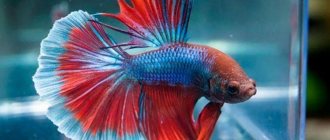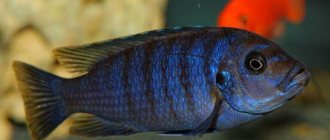The lifespan of a catfish depends on its variety and conditions of detention. The average lifespan of an individual is about 8 years. In the wild, large species can live to be 100 years or more. It is possible to keep about 800 varieties of catfish in an aquarium. Thus, a popular species is the chain-mail catfish, covered with fused bone plates. It has a bottom sucker mouth and loves to feast on algae. This species includes catfish Ancistrus, Otocinclus, Loricaria, Sturisoma, whose life expectancy in good conditions is limited to 8 years.
Also common in the aquarium hobby are armored, or callichtaceous, catfish, distinguished by two rows of bony plates. A special feature of the fish is its ability to breathe atmospheric air. This species includes corydoras, dianema and tarakatum, which live on average 6-7 years.
The armored family, which is characterized by covering the body and head with bony plates and three pairs of long mustaches, is also popular. The most popular representatives of the armored species are considered to be agamixis and platidoras, which live up to 15 years at home, and up to 20 years in the natural environment.
The lifespan of catfish from the fringed catfish family is 5-15 years, but there is evidence of individuals that have lived up to 23 years in nature.
Another common inhabitant of aquariums is the colorful flat-headed catfish, or pimelodaceae. In nature, it has a fairly long lifespan, but it is impossible to give exact figures, but in an aquarium, a representative of the family, for example, Sorubium paddlefish, lives from 5 years or longer.
Selection and arrangement of an aquarium
Aquarium catfish is an unpretentious fish. To keep it at home you will need a spacious aquarium with a wide bottom. The only important condition is that the water in the container must be replaced on time and there must be a good filtration system.
Volume
You should choose a home pond depending on the size of the aquarium fish that will live in it. If for small species of catfish a container with a volume of 50–200 liters is sufficient, then for larger representatives the minimum tank volume is 300 liters.
Decor
The aquarium should have houses for fish, since without shelter they will be uncomfortable. Usually, to do this, there should be enough driftwood and stones in the aquarium so that the catfish can hide under them during the day and have a good rest before dusk. Since most catfish lead a solitary lifestyle, without good shelter they can suffer greatly.
Water
Aquarium catfish should be kept in clean, filtered, unsalted water, as in nature they prefer fresh water bodies. The liquid temperature should be 22–28 °C. Thanks to cutaneous respiration and the ability to breathe ordinary air, catfish rise to the surface, filling their lungs. This quality makes the fish unpretentious to the oxygen regime.
Lighting
Most catfish living at home choose the dark time of day to stay awake. Therefore, there is no need to additionally supply the aquarium with lighting devices. They are comfortable with dim light, and if it is possible to provide them with constant partial shade, then the fish will be able to swim out during the daytime.
Plants
It is recommended to choose vegetation depending on the type of catfish that will live in the aquarium. For vegetarian fish that eat exclusively plant foods, it is better to organize plantings of artificial algae. Natural ones will be eaten very quickly. Of living plants, only representatives with a good root system, such as cryptocorynes and echinodorus, are suitable.
Priming
Aquarium catfish are not picky when it comes to choosing soil. Some species that like to “comb” the bottom of the container raise clouds of turbidity if it is covered with sand. For them it is better to choose coarse-grained soil. The only exception is gravel, which can damage the fish's abdomen and antennae.
general description
The number of species of aquarium catfish is huge. There are miniature species, not exceeding 2-3 cm in length, and large fish, reaching up to 40 cm or more. The colors of catfish are very different.
External characteristics and behavioral features common to all catfish:
- The abdomen is flattened, allowing the fish to move comfortably above the bottom soil.
- There are sensitive whiskers near the mouth that help to navigate in space and grope for food.
- Absence of scales on the body.
- Many species have sharp fin spines and bony plates on the body.
- Bottom lifestyle.
- Activity in the dark.
Aquarium catfish are not capricious in maintenance and care. It is enough to create standard conditions for them so that they live long, remain healthy and active. In good conditions, pets live on average 8 years - this is a considerable age for freshwater inhabitants.
Representatives of the fringed fish family, the synodontis catfish, are also of great interest to aquarists. How long can they live in an aquarium? From 5 to 15 years. According to some data, in nature, some individuals live more than 23 years.
Content
Caring for catfish in an aquarium will not cause much trouble for the owner. An important condition for the survival of these fish is timely feeding. If the reservoir is equipped with shelters, algae grows, and a comfortable temperature and water hardness are ensured, then caring for them is a pleasure.
What to feed catfish
Feeding catfish will also not cause much trouble for the owner. If there are other fish in the aquarium, there is no need to feed the catfish specially. They perfectly feed on the remains of food lying on the bottom, while simultaneously cleaning it, so you don’t have to specially feed them. Pieces of fish, shrimp and flakes sold in pet stores are ideal food for aquarium catfish. In addition, small neighbors in the aquarium can become food for predatory representatives. When choosing such species, you need to remember that catfish can eat small fish.
Catfish eats
How long do catfish live?
The largest representatives living in nature can live up to 100 years, but domestic fish are not so long-lived. Depending on the type of catfish and the conditions of its keeping, the average lifespan of catfish is 8 years, provided that aquarium catfish live in suitable conditions.
Causes of early death
In addition to death due to age, aquarium catfish can die for other reasons.
Diseases
In general, this is a fairly disease-resistant fish, but due to improper housing conditions, the catfish’s immunity may decrease, which provokes infection. For example, a catfish can get sick if the level of organic suspended matter in the water increases. Sometimes the slow-moving brocade catfish suffers from malnutrition, since its more nimble neighbors manage to eat its food. All these factors can lead to illness and subsequent death.
Incorrect treatment
An inexperienced aquarist begins to treat the catfish and thereby only aggravates the situation.
First of all, it’s worth figuring out whether the catfish needs treatment at all. For example, some species can suddenly change color and become covered in spots, and the frightened owner immediately begins intensive rehabilitation. In fact, this phenomenon is most often a reaction to stress and has nothing to do with illness. When the individual calms down, its previous color will return. Also, some breeders are alarmed when they see the pet's passivity. It is worth knowing that most individuals prefer to lead a nocturnal life, and in daylight such species become less active.
Remember that these fish cannot tolerate salt baths and preparations containing copper, although this is how other aquarium fish are usually treated. Therefore, avoid this type of treatment.
Thus, it is not recommended to treat catfish with Ectopur, Oodinopur and Mycopur - a concentration of copper sulfate of more than 0.25 mg/liter becomes fatal for catfish. As a last resort, use these products in very small dosages.
Illiterate breeding
An inexperienced owner has little knowledge of the breeding characteristics of catfish, so he does not specifically select suitable individuals, but takes the first pair he comes across for production. However, there are cases when a large male killed a more fragile female during the spawning period. Therefore, in order to avoid the early death of a female, it is recommended for breeding to select parents of the same size or a female whose mass is greater than the male.
Injuries
Some species, for example, Sturisoma, have an elongated long body that can fit into any hole. Often the curiosity of such a catfish leads it into the filter structure, where it dies. Such death is possible not only for catfish with a certain body shape, but also for young catfish of any variety.
Catfish can also be injured if kept in unsuitable water or in too small an aquarium. Thus, some species, for example, tarakatum or synodontis, have a tendency to jump out of the water under uncomfortable conditions.
If the owner notices the body lying on the floor in time, then it can be saved, but alas, the owner cannot be near the aquarium all the time. Even if you close the container with a glass lid, this will not protect your jumping pet from injury: he can break his nose on the glass, although in most cases this damage is not fatal.
Compatibility with other fish
When buying fish, you need to know exactly who the catfish get along with in the aquarium, because each species has its own preferences.
In life, these catfish are very peaceful, they do not start fights with other inhabitants of the reservoir, but they can conflict with each other. The only threat to them comes from large fish, for example, large astronotus, which are capable of swallowing their prey whole.
Some species of speckled catfish will not get along with tail-biting fish.
Catfish are not compatible with small fish such as guppies or neons - they can become food for predators. It is better to add herbivorous species of catfish to such neighbors.
How long will an aquarium catfish live?
Catfish are unpretentious and beautiful fish that even aquarists with little experience can breed without problems.
Catfish are schooling beautiful fish that get along well with many non-aggressive species of the inhabitants of your aquarium!
A large predator reaches a length of 40 cm. An anatomical feature is the presence of a pair of lungs that help the fish live for several hours when the reservoir dries out. The sacbranch catfish should be handled with care: it has spines on its body that contain a toxin that causes pain and numbness in the affected area.
Reproduction
You can stimulate the reproduction of catfish by lowering the water temperature in the aquarium. The spawning period lasts up to 5 days, and during this time the female and several males must be transplanted into a spawning tank - a special container with a volume of 30 to 70 liters. You can also breed fish in a plastic basin if there is no other free container. It is advisable to additionally equip it with driftwood and plants so that the fish feel comfortable. The suitable water temperature for breeding catfish is 18–20 °C.
Catfish fry
The main thing is to correctly determine the sex of the fish. It is usually not difficult to distinguish a female from a male; the male has a brighter color and a slender body. Changes in water temperature accelerate the onset of spawning. Courtship lasts about 1 week, while the male tries to show himself in all his glory. He circles around the lady, trying to arouse her interest. When the female pays attention to him, the male touches her with his antennae, indicating his readiness to reproduce.
Reviews from aquarists
My seasoned platidora crawled out of his hiding place, I looked at this miracle and wondered how old he was? They gave it to me along with a hundred-liter aquarium, the owner was selling the aquarium and gave me this miracle as a bonus, with the words “take him, he’s left alone and won’t live long, he’s about six years old already, and he’s been living in a rotten jar for the last months, which there was no one to deal with.”
The aquarium really looked like it was in a deplorable state, it was all overgrown... Well, that’s how I took this beast... This was around 2003. After a while, the owner of the aquarium, having learned that the animal was alive, was very surprised... The ending of the story is this: it is 2015, the catfish is still alive and what is most surprising is that it is in excellent mobile condition (I specially examined it from all sides), this means he is 18 years old?
In addition to this catfish, I also have a girik, I bought it in February-March 2002, it is also vigorous, alive, chasing and building everyone in the aquarium.
Natalia
An ordinary Ancistrus has been living in my aquarium for seven years now... Daddy is wonderful.
Andrey
I have had acanthus in my aquarium since about 2003, there were three of them, recently I saw two, and at the moment there is only one left.
Ruslan
My friend has had a Pter since 1999, in a healthy 700 liter jar, about forty centimeters in size. In general, catfish live much longer than other aquatic animals purchased on the market. Why this is so, it’s better to find out from professionals, just as far as I know, the lifespan of fish in an aquarium is calculated at a couple of years, then they either die or get bored and pass into the hands of the next aquarist.
Maria
Catfish live for at least 10 to 15 years and often die from stupid, even sometimes ridiculous mistakes of their owners; neither a pro nor a student is immune from this.
Alexander
I have an agamix swimming, which I bought in 1997. In addition to my oldest catfish, I have another male ancitrus from 2000, from 15 to 17 centimeters long.
Novel
Where does this information come from? Even an ordinary anz lives for about 10 years, many even longer; large L catfish live for decades.
Ramon
...I assume that my acanthic catfish will even outlive me... even if I now stop drinking, smoking, eating... and switch to a low-carb diet... my monster is my luggage, which I will carry until my death...
Sergio
Exactly a year ago, I managed to exchange a pair of L181 catfish from an employee at work, asking the owner how old they were? She replied that about seven years!!!
Interesting: What do barbs eat?
I managed to breed catfish, the fry were born on May 9th.
Valentina
This is all nonsense, 7 years. I read in the literature about wild male 046, who is now 15 years old and still takes part in spawning. But we are talking about a small species of catfish. Just imagine how many years large acanthics and panacians live.
Albert
It’s good that there are 14 years old, otherwise I thought mine were quite old. But it turned out not old, but experienced.
Nikita
Adviсe
When keeping striped catfish you need to pay attention to:
- On the composition, quality and quantity of feed. A lack of necessary substances, as well as an excess of them, will lead to the death of the fish.
- Monitor the hygiene of new decorative elements, equipment, and soil. Do not neglect thorough washing and disinfection.
- Do not immediately introduce new fish into the pond. The minimum quarantine period should be 7 days in a separate tank.
- Monitor nitrogen and nitrate levels in the aquarium. Exceeding the indicators can lead to the death of the entire biosphere of the aquarium, and not just platidoras.
- Singing catfish have hard spines on their bodies; this must be taken into account when trying to place the fish in a separate aquarium. They easily break through the fabric of a net for catching and often suffer serious injuries themselves. To catch platidoras, you need to use a net with thick cotton fabric.
- If a catfish is sick, then you should not treat it with drugs based on manganese or copper - these substances are harmful to them.
Platidoras is a very interesting fish. Its peaceful disposition allows it to be placed in a multi-species aquarium , and its unpretentiousness will allow even a novice aquarist to cope with its maintenance.











